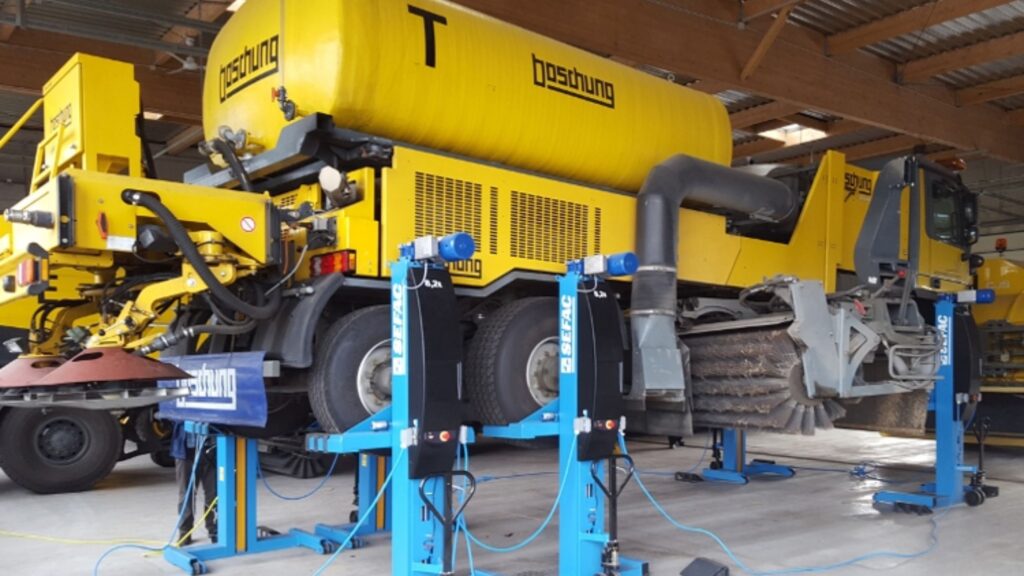
Safety is one of the top priorities in any auto repair shop, especially when lifting heavy vehicles. One common debate among mechanics and shop owners is whether mobile column lifts offer the same safety as traditional fixed lifts. The use of mobile column lifts has grown over the years, but many people still wonder how they compare to more permanent lifting solutions in terms of reliability and safety.
In this blog, Coats Company explores the safety aspects of both types of lifts, highlights key differences, and provides guidance to help shop owners make informed decisions.
Understanding the Basics: What Are Mobile and Fixed Lifts?
Before comparing the two, it’s important to understand what each lift type offers and how they operate.
A mobile column lift is a freestanding lifting system that consists of multiple movable columns. Each column can be positioned around a vehicle’s wheels to lift it off the ground.
A fixed lift, such as a two-post or four-post lift, is permanently anchored to the ground. These are typically installed in one location and cannot be moved.
The Growing Popularity of Mobile Column Lifts
More shops are adding mobile column lifts to their operations. This trend is being driven by flexibility, improved technology, and evolving shop needs.
Portability and Space-Saving Benefits
Mobile column lifts can be moved when not in use, which helps free up space in smaller shops. This is particularly valuable for multi-purpose workspaces.
Compatibility with Heavy Vehicles
Many mobile lifts are built to support trucks, buses, and other heavy-duty vehicles. Coats Company offers models with lifting capacities ranging from 16,000 to over 20,000 pounds per column.
Safety Features Found in Mobile Column Lifts
Modern mobile lifts come equipped with several safety features that protect both mechanics and vehicles during operation.
Automatic Locking Systems
Mobile column lifts often have built-in locking mechanisms that automatically engage at various heights, preventing the lift from dropping unexpectedly.
Synchronized Lifting Technology
Each column is electronically or hydraulically synchronized to ensure even lifting. This prevents tilting, which can damage the vehicle or endanger the operator.
Emergency Stop Controls
If something goes wrong, operators can hit the emergency stop button, instantly halting the lift’s movement.
How Do Fixed Lifts Handle Safety?
Fixed lifts are generally considered stable and secure due to their permanent anchoring and solid construction.
Reinforced Steel Frames
Most fixed lifts are made with heavy-duty steel and secured deep into concrete foundations, giving them excellent stability.
Built-in Arm Restraints and Locks
Two-post lifts often feature arm restraints that engage automatically when the lift is raised. Four-post lifts use safety catches at each height level.
Visual Safety Indicators
Many fixed lifts have color-coded or LED-based safety indicators to inform users of the lift’s status.
Safety Comparison: Mobile vs. Fixed Lifts
Let’s look at how mobile column lifts stack up against fixed lifts in key safety categories.
Stability
Fixed lifts offer constant stability because they are permanently secured to the ground. However, mobile column lifts with locking casters and synchronized lifts can be equally stable during operation.
Load Distribution
Both lift types offer even load distribution if used correctly. Mobile lifts depend more on setup accuracy, whereas fixed lifts are preset.
Operator Error
Mobile lifts may have a slightly higher chance of misuse if columns are not placed properly. Fixed lifts remove some of this risk because of their fixed arms and positions.
Emergency Handling
Mobile lifts often include portable emergency controls on each column. Fixed lifts rely on a single control point, which could be a drawback in some urgent situations.
Case Study: A Garage’s Shift from Fixed to Mobile Lifts
A commercial garage in Ohio transitioned from using only fixed lifts to incorporating mobile column lifts.
The Situation
The shop handled a wide range of vehicles, from compact sedans to large delivery vans. Their existing fixed lifts couldn’t accommodate larger vehicles.
The Change
They invested in four mobile column lifts with 18,000-pound capacity. Staff were trained on proper positioning and safety measures.
The Outcome
In six months, the shop reported a 20% increase in job completion speed and zero reported safety incidents. Mechanics appreciated the flexibility and updated safety features.
Training and Certification: Ensuring Safe Use
No matter which lift you choose, proper training is essential for safety.
Operator Training
Both mobile and fixed lifts require training to ensure correct operation. Coats Company offers training guides and certifications for its mobile lift systems.
Regular Inspections
Technicians should perform daily inspections for wear, leaks, or damage. Annual third-party inspections are also recommended.
Maintenance Routines
Proper lubrication, cleaning, and calibration are key to safe operation. Follow the manufacturer’s maintenance schedule.
Common Myths About Mobile Column Lift Safety
There are several misconceptions that prevent some mechanics from switching to mobile systems.
“They’re Not Stable Enough”
This is untrue when using certified mobile lifts from trusted providers like Coats Company. Modern systems are engineered for heavy loads and long-term durability.
“Only Fixed Lifts Are OSHA-Approved”
Both lift types can be OSHA-compliant as long as they meet ANSI/ALI ALCTV standards and are properly maintained.
“Mobile Lifts Are Too Complicated”
Current mobile lifts feature user-friendly controls and smart systems that guide the user during operation.
Which Is Better for Your Shop?
Choosing between a mobile or fixed lift depends on your workspace, vehicle types, and daily workload.
Choose Mobile Column Lifts If:
-
You handle many vehicle sizes
-
You have limited floor space
-
You need to move your equipment often
-
You want flexibility in vehicle positioning
Choose Fixed Lifts If:
-
You service the same vehicle types daily
-
You have space for permanent setups
-
You prefer traditional tools and layouts
The Coats Company Commitment to Safety
At Coats Company, safety is part of every product design. Our mobile column lifts are built with:
-
Heavy-duty steel construction
-
Automatic safety locks
-
Wireless synchronization options
-
Full operator training support
We ensure that every customer receives detailed safety guides and real-time support during and after purchase.
Future Innovations in Lift Safety
As vehicle tech grows, so does the need for smarter, safer lifting systems.
Smart Lift Sensors
Upcoming lifts may include sensors that detect improper positioning or weight imbalance before lifting.
Remote Monitoring
Technicians will soon be able to monitor and control lifts via smartphones or tablets, adding another layer of safety.
Integrated Diagnostic Tools
Some lifts will feature onboard diagnostics to alert users about maintenance needs or performance issues.
Final Thoughts
So, how safe are mobile column lifts compared to fixed lifts? The answer is: very safe when used correctly and purchased from a reputable provider. While fixed lifts have long been considered the standard, mobile column lifts now offer comparable safety features, better flexibility, and enhanced workshop efficiency.
With trusted brands like Coats Company leading the way, workshops can invest in mobile lifting solutions without compromising safety or performance.
Here, you can find more articles.
